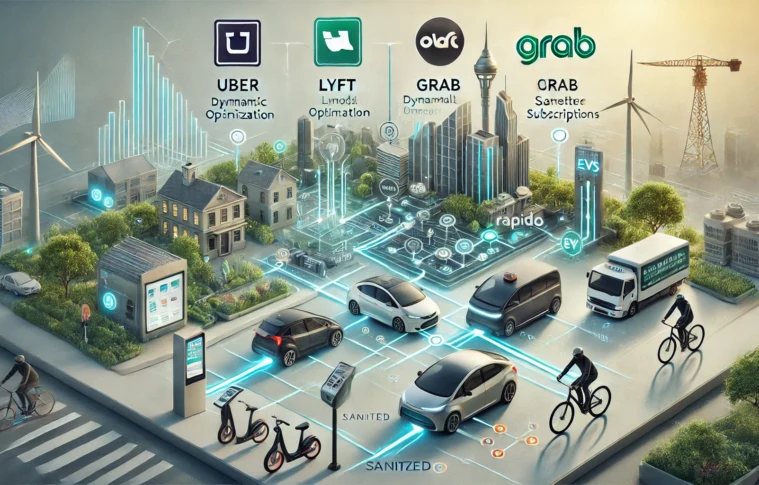The ride-sharing industry has grown into a pivotal component of global urban mobility, driven by innovation, evolving consumer needs, and regulatory developments. Companies like Uber, Lyft, Grab, Ola, and Rapido are leading the charge in redefining mobility by adopting cutting-edge strategies and addressing pressing challenges. This case study delves into six critical trends influencing the industry and highlights how these companies are leveraging them to create sustainable growth and enhance user experiences.
1. Dynamic Pricing Optimization
Dynamic pricing, a system that adjusts fares based on supply and demand, is a cornerstone of the ride-sharing business. While it helps manage service availability during peak times, it often draws criticism due to sudden cost spikes, causing customer dissatisfaction.
- Uber introduced Upfront Pricing, offering riders fare estimates before booking. This initiative increased transparency and helped mitigate negative perceptions of surge pricing.
- Ola has focused on enhancing its AI-driven pricing algorithms to ensure dynamic pricing remains competitive while minimizing fluctuations that inconvenience riders.
- Rapido, specializing in bike-taxi services, has balanced dynamic pricing with affordability, appealing to price-sensitive customers in Tier 2 and Tier 3 cities.
By improving pricing transparency and balancing affordability with driver incentives, these companies are refining the dynamic pricing model to better serve their markets.
2. Electrification of Fleets
Sustainability has become a top priority in the ride-sharing sector, with leading companies investing heavily in electric vehicle (EV) adoption.
- Grab has partnered with Hyundai to launch EV pilot programs across Southeast Asia, aiming to create eco-friendly ride-sharing options while reducing long-term operational costs.
- Ola Electric, a subsidiary of Ola, has made strides in manufacturing electric two-wheelers and integrating them into its ride-sharing fleet. This approach positions Ola as a leader in green mobility.
- Uber has committed to transitioning to a 100% electric fleet by 2030 in key markets and incentivizes drivers to switch to EVs through subsidies and charging infrastructure partnerships.
Electrification is not just an environmental initiative but a strategic move to meet regulatory demands and gain early-mover advantages in sustainable transportation.
3. Integration of Multi-Modal Transport Options
To cater to diverse customer needs, ride-sharing platforms are expanding into multi-modal transport solutions, offering more flexibility in urban mobility.
- Lyft has integrated bike and scooter rentals alongside its traditional ride-hailing services, creating a one-stop app for all urban transportation needs.
- Ola has experimented with integrating public transit information within its app, helping users plan seamless journeys that combine ride-hailing and public transportation.
- Grab offers a similar approach, allowing users to access ride-hailing, bike rentals, and even food delivery in a unified app experience.
This trend positions companies as comprehensive mobility platforms, increasing user retention by offering diverse solutions.
4. Focus on Safety and Health Measures
The COVID-19 pandemic underscored the importance of safety and hygiene, prompting significant changes in ride-sharing protocols.
- Uber implemented health measures such as mask mandates, in-app health checks, and a fund to support drivers affected by COVID-19.
- Ola introduced features like “Ola Emergency”, enabling users to book rides for medical purposes during lockdowns.
- Rapido enforced stringent sanitization measures for its bike-taxi services, appealing to riders seeking safe and hygienic travel options.
These initiatives have set new benchmarks for safety in ride-sharing, fostering customer trust in a post-pandemic world.
5. Expansion into Rural and Tier 2/3 Markets
As urban markets become saturated, ride-sharing companies are targeting underserved regions to drive growth.
- Lyft has expanded its services to rural areas in the U.S., addressing the mobility gap and tapping into new revenue streams.
- Ola has aggressively expanded in India’s Tier 2 and Tier 3 cities, tailoring services to local needs, such as cash payments and affordable ride options.
- Rapido, focusing on bike-taxis, has gained traction in smaller cities by providing economical and convenient transportation alternatives.
Expanding into these regions helps companies diversify their user base and capture opportunities in emerging markets.
6. Adoption of Subscription Models
Subscription-based services are becoming a popular way for ride-sharing companies to retain loyal customers and generate predictable revenue.
- Uber Pass and Lyft Pink offer perks like discounted rides, priority pickups, and reduced delivery fees for a monthly fee.
- Ola Select provides benefits such as zero cancellation fees, priority customer service, and free Wi-Fi for frequent riders.
- Grab launched a subscription service for users combining ride discounts with food delivery benefits, broadening its appeal to everyday users.
These models not only boost customer loyalty but also create steady income streams in a competitive market.
Conclusion
The ride-sharing industry is at the forefront of innovation, continuously adapting to meet evolving customer expectations and market challenges. Companies like Uber, Lyft, Grab, Ola, and Rapido exemplify the importance of embracing new trends, from sustainability and safety to pricing transparency and rural expansion. By staying agile and forward-thinking, these companies are not only redefining mobility but also shaping the future of transportation globally.



